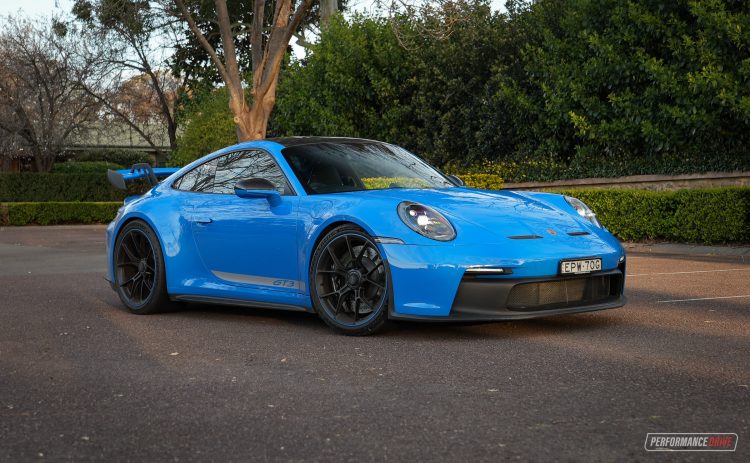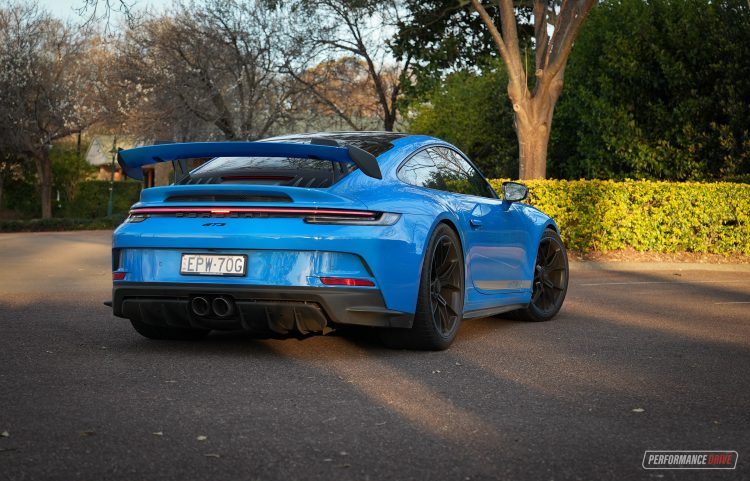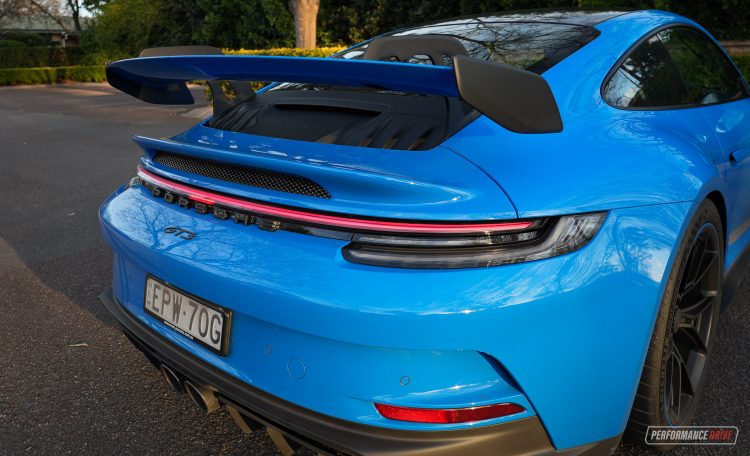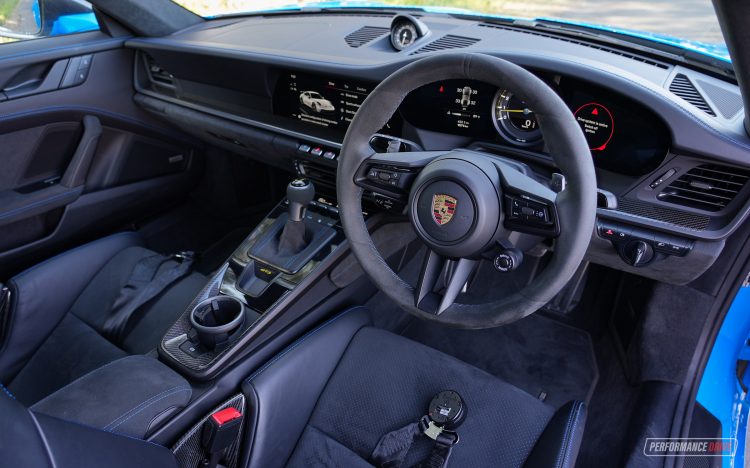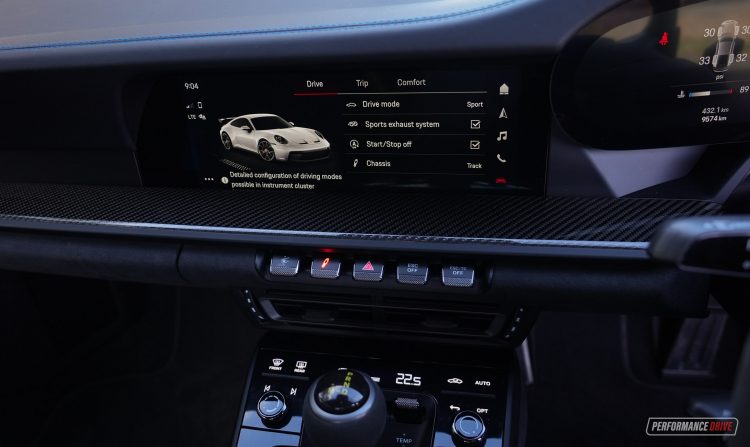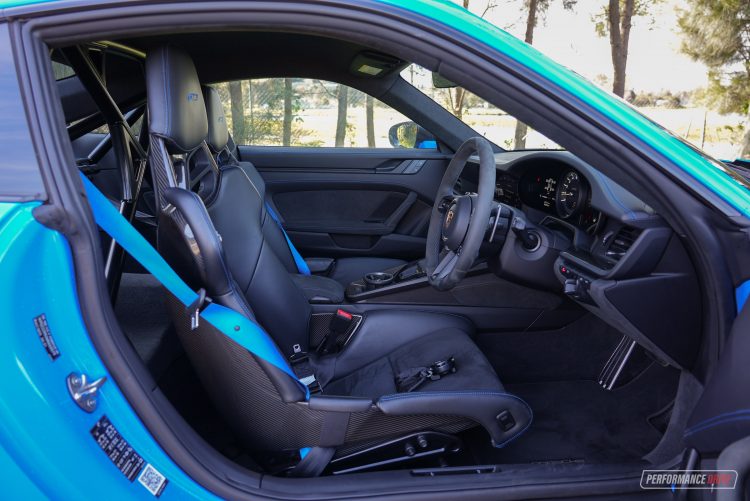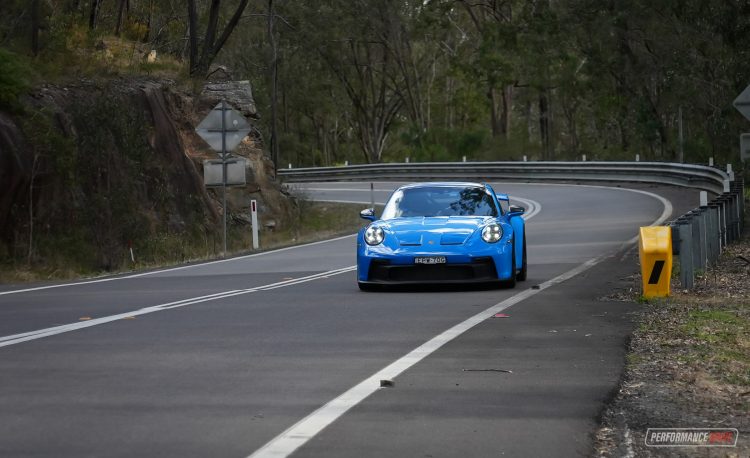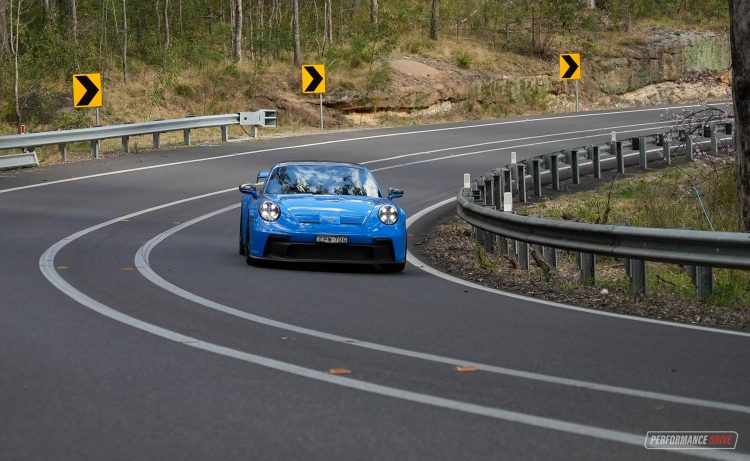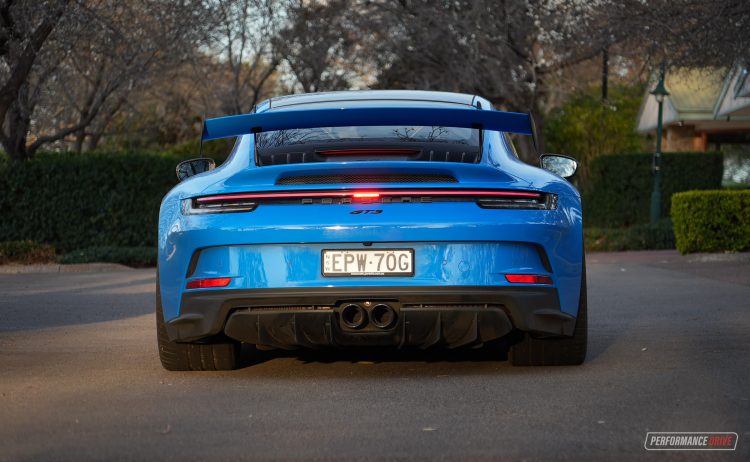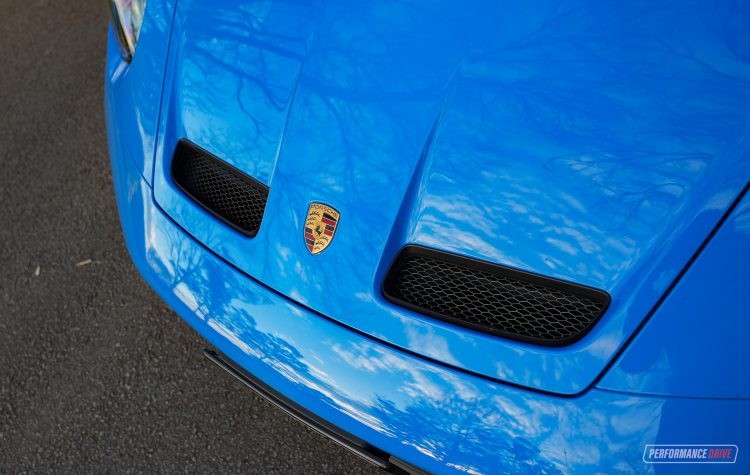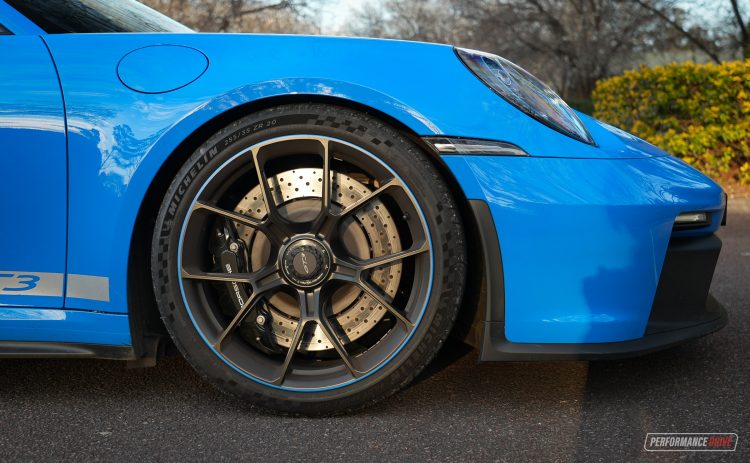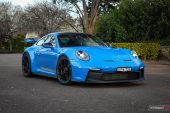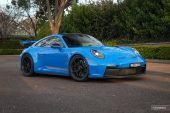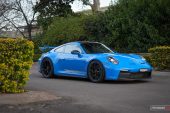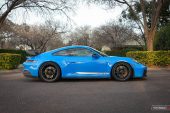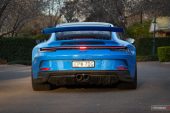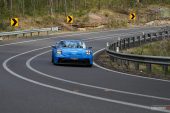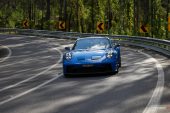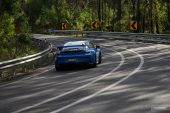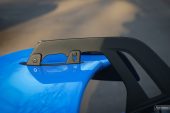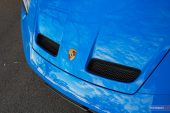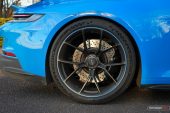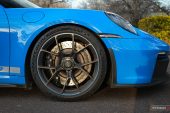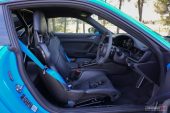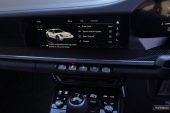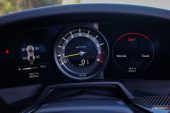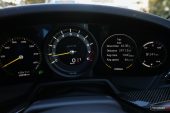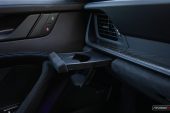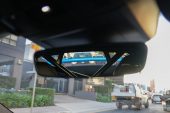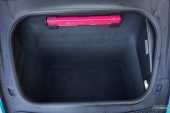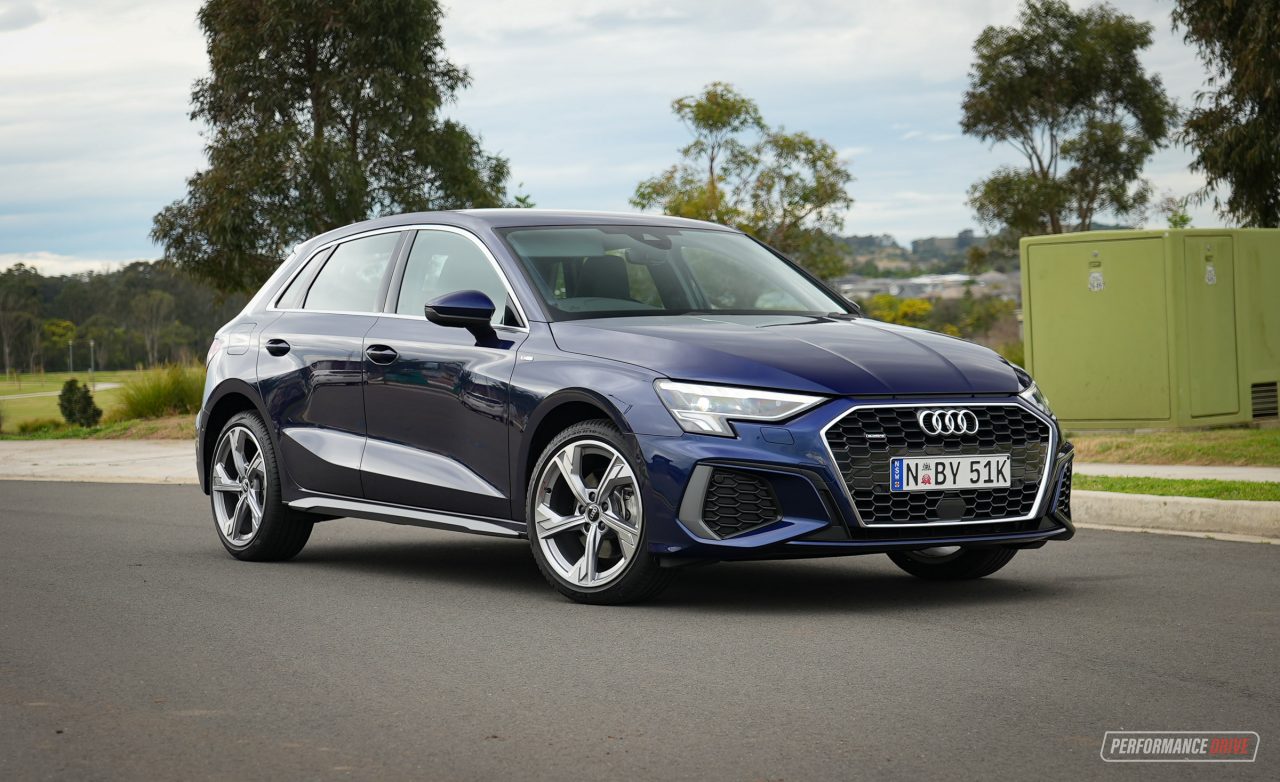When anybody mentions the words ‘ultimate track car’, most of us immediately think of the Porsche 911 GT3. It revs to 9000rpm. It’s available with a manual transmission. And it even comes with a roll cage and fire extinguisher, if you want it to. Named after the official FIA racing series, Group GT3, it doesn’t get more ‘racing car’ than this.
Even though this is the new-generation 992 model, you can think of it as a facelift, of a facelift, of a facelift of what was once the best road legal track car Porsche could come up with, back in 1999. That’s when the 911 GT3 road-car story began. The GT3 is a constant evolution, in other words, rebuilding on areas that would no longer work in today’s world, while improving, honing, and perfecting areas that make the biggest and best improvements on the track.
As a result, the 2022 GT3 is the fastest iteration yet when it comes to lap times. It can lap the Nurburgring, which is a hugely challenging and demanding circuit with road-like bumps and off-camber corners, in an astonishing 6:59.927 – or 17.5 seconds quicker than its predecessor. The new GT3 has also set an outright lap record at The Bend Motorsport Park in South Australia for a production car, posting a time of 3:17.05.
Now, this is where things get a bit difficult, or even sad for some lucky people out there. Although the GT3 is technically on sale, the complete allocation for Australia for 2023 is sold out as far as we know. And in fact we’ve heard really loyal customers are getting in line to put their name down for the next ‘992.2’ version. So if you want one, our best advice is to speak with your local Porsche dealer as soon as possible about joining the queue.
Prices for this model start from $388,600, and that’s for either the six-speed manual or seven-speed dual-clutch auto. Here we’re testing the latter.
2022 Porsche 911 GT3 – THE SPECS
[column width=”47%” padding=”6%”]Engine: 4.0-litre flat six-cylinder
Output: 375kW@8400rpm / 470Nm@6100rpm
Transmission: Seven-speed dual-clutch auto
Drive type: Rear-wheel drive
Wheels: F: 20×9.5, 255/35 R: 21×12, 315/30
ANCAP: Not tested
Tare weight: 1396kg
Power-to-weight: 3.72:1 (kg:kW)
Official fuel economy: 12.6L/100km
Economy during test: 13.8L/100km
Fuel capacity/Type: 64L/98 RON[/column] [column width=”47%” padding=”0″]Power efficiency: 29.76kW:L/100km
0-60km/h: 1.89 seconds*
0-100km/h: 3.62 seconds*
0-200km/h: 11.23 seconds*
60-110km/h: 2.22 seconds*
1/4 mile: 11.51 seconds at 202.9km/h*
Max acceleration: 1.127g
100-0km/h braking: 2.81 seconds at 34.56 metres*
Max deceleration: -1.197g
Decibel at idle (/Track mode): 59/62*
Peak decibel at 60-100km/h: 101*
Priced from: $388,600[/column][end_columns]
* Figures as tested by PerformanceDrive on the day. Factory claims may be different
2022 Porsche 911 GT3 – THE PACKAGE
We think the latest 992 version looks absolutely breathtaking. We love the view from the back, in particular, with its iconic haunches swelling out wide, with a crazy-big wing on the back featuring a top-hanging mount for a completely clean and large under-surface area. There’s also a full diffuser below with chunky fins, and trademark twin exhausts poking out right in the middle.
Regardless of how good it all looks – and even if you don’t agree – everything you see here is there for a purpose. The wing, for example, is not just bigger for the sake of being bigger. It can generate 50 per cent more downforce than the previous wing in the standard setting. Loosen off the adjuster bolts and tilt the wing into its most aggressive angle and it’ll produce 150 per cent more downforce than the old model, when travelling at 200km/h. It’s serious stuff.
These wheels are made from forged alloy and feature centre-locking nuts, just like an actual racing car. They measure 20 inches on the front and 21 on the back. Perhaps more impressively, they are 12 inches wide on the back too, with whopping 315/30 tyres. Porsche has employed 255/35 tyres on the front, up from 245/35 on the previous 991 edition and up from 235/35 on the old 997 version.
Inside, this example is optioned with the Club Sport pack and the full racing bucket seats. The Club Sport pack adds six-point harness belts, a fire extinguisher, and provisions for a battery disconnect switch. If you’re planning on regular track days, and we’re guessing you are if you’re considering a GT3, then this option is a must.
If you’re not planning on hitting the track that often Porsche also offers the Touring pack, which kind of goes the other way, deleting the big rear wing and adding some premium-focused trimmings inside and out.
Even with the Club Sport pack there are some creature comforts, such as cup holders, a big 10.9-inch touch-screen offering a range of Porsche apps and services, including a rear-view camera and sat-nav, and this test car features the optional Bose sound system. There’s also climate control, and even a nose-raise function available for the front end so you don’t scrape on speed bumps.
The semi-digital instrument cluster features a GT3-exclusive Track Screen display option, which shows the driver only the critical information, allowing you to focus more on the corners and braking points and so on. The live tyre pressure monitor is also revised so it knows when the tyres are cool and warm and thus provides a more accurate readout.
These seats are pretty much like moulded body wraps. And you need them, because the cornering g-forces when driving this machine can be very high. Surprisingly though, they are quite comfortable. We spent a number of hours in them during filming and testing, including on somewhat bumpy mountainous roads, and jumped out without feeling fatigued or sore. However, if you’re quite tall or a bit rounder than you’d like to be, the high bolsters might be a squeeze.
You can forget taking passengers in the back, as that space is occupied by the roll cage. There is a bit of boot space under the bonnet though (132L), enough for a couple of overnight bags and a helmet. You can also stuff bags (or helmets) in between the roll bars.
2022 Porsche 911 GT3 – THE DRIVE
Firstly, this engine. What an engine. It’s based on the long-running MA-series of flat-six units from Porsche, which means it has one of the most extensive histories the industry has ever seen. With that history comes experience. So it’s no wonder the on-paper stuff doesn’t look all that different from the old model. This is about nudging the benchmark forward from an already high level. Power is turned up by 7kW and torque is lifted by 10Nm over the predecessor.
However, peak power is now reached at 8400rpm, up from 8250rpm, and max torque is not available until you let it spin to 6100rpm instead of 6000rpm. It’s not much of a difference but it all matters on the track.
Torque is a lot more complimentary than you might expect from a high-revving, naturally-aspirated engine. It actually pulls quite hard from the mid-point of the tacho. And it’s here where the engine sings a beautiful baritone note.
Upshifting early gives you a decent shove and then you can use the full rev range all over again, which can be handy in technical sections on a track where you have two tight corners linked up, exiting onto a long sweeping bend. We’ve put together a POV-style test drive video below to showcase the car’s low-end tractability around some corners, so you can see how well it pulls away, surging, almost like a turbocharged engine.
Part of that is thanks to the variable intake manifold which optimises airflow into the engine at “all engine speeds”, according to Porsche. The company’s VarioCam technology also optimises valve timing throughout the rev range, with six individual throttle butterflies getting their own dose of air and fuel.
Dry-sump lubrication is of course applied here, being a racing-derived engine. Although it’s primary purpose is to ensure proper oil flow regardless of cornering g-forces, the crankshaft counterweights don’t have to smash into a pool of oil each time they swing around, which would otherwise slow down response to some degree. Dry-sump also means a larger capacity of oil, which in turn optimises heat dissipation. There’s also a lower centre of gravity with dry-sump since the sump doesn’t have to hang low from the engine (the engine can be mounted lower).
Other technical goodies include a new stainless steel exhaust system which saves 10kg over the predecessor, lighter weight glass for all windows, a lighter carbon fibre bonnet and option carbon roof, and a 60Ah LiFePO4 starter battery that saves around 10kg over the previous setup. As a result, the new model offers a tare weight of 1396kg according to Redbook, in standard configuration. That makes it 4kg heavier than the 991 model with the PDK.
Why is it heavier? Well, some of it likely comes from the new double-wishbone front suspension setup. This is considered a superior design over the conventional MacPherson strut as it provides more control and bracing for the front wheel, and helps to maintain a more consistent tyre contact patch on the ground as the car turns, including during suspension compression. The camber angle automatically moves (in the optimum direction) as the suspension compresses down.
One could argue there is a slight sacrifice in braking performance in a straight line due the camber angle changing, but Porsche is on top of that as well and has engineered the geometry to offer anti-dive characteristics. In other words, the nose hardly squashes down during hard braking. The suspension is adjustable too, and not just with adaptive dampers. Users can dial in changes to the toe angle, camber and stabiliser bars. Did we mention this is a race car?
Out on the road it is just phenomenal, as you probably already assumed. We’ve driven one on the track before, which is where it obviously belongs, but we can confirm it will happily drive on regular roads. The suspension is suitably firm but not unbearable. In fact, it soaks up bumps with more forgiveness than you might expect. The engine is extremely refined, too, so it’s not a pig to drive at low speeds.
Visibility through the rear is a bit of a challenge due to the cage, and the bodykit obviously hangs pretty low – the nose-raise function is very handy in urban situations. Other than that, this is a very exciting car to drive not just on the track, but on regular roads as well. The theatre and presence of the car, standing still, is truly awe-inspiring.
Although the handling is incredible, on the road you don’t really get a chance to explore its full potential. For us, it’s the epic engine that stands out most (for this test). The character and noise is just sensational, especially through a mountain road where sounds can bounce and echo off rocks and gorges. It’s enough to send goosebumps down your spine. On that note, we’ll shut up now so you can witness the sound and drive experience yourself in the videos below.
2022 Porsche 911 GT3 – THE VIDEO
2022 Porsche 911 GT3 – THE VERDICT
This is the epitome of road-legal track cars in our opinion. It’s so well balanced and so experienced – more experienced than you or me – it’s impossible to criticise. Porsche engineers from its GT car division, with help directly from the motorsport division, have essentially been working on this car for decades. If there’s any chance something could be improved, the team behind this machine – including race car drivers and engineers – would have already implemented it.
[column width=”47%” padding=”6%”]PROS:
– Mind-blowing handling yet not overwhelming
– 9000rpm flat-six; this is what dreams are made of
– Looks absolutely stunning
– Attention to detail in aerodynamics
– Usual Porsche build quality
[/column] [column width=”47%” padding=”0″]CONS:
– You need to be quick getting onto the customer list
– It’s very difficult to stop driving it…[/column][end_columns]
As always, if you’re thinking about buying a new car don’t forget to click here to speak with our car buying specialists.
